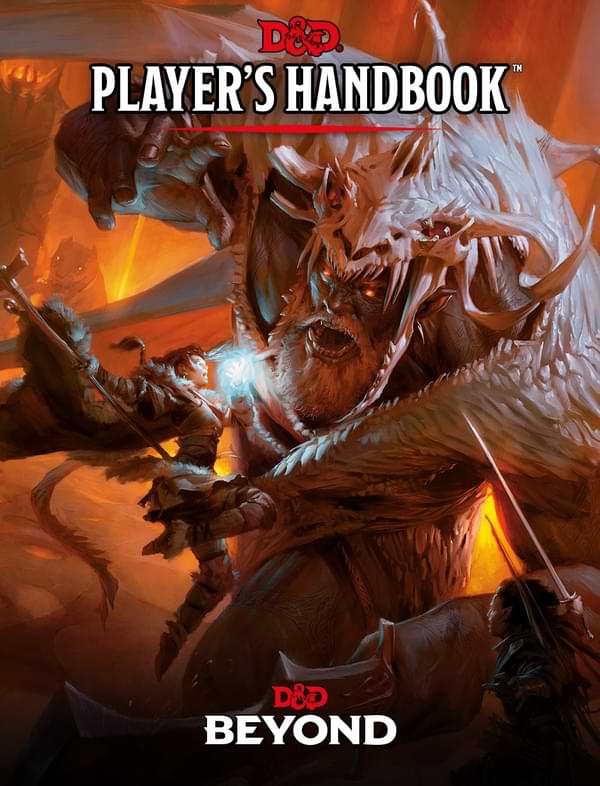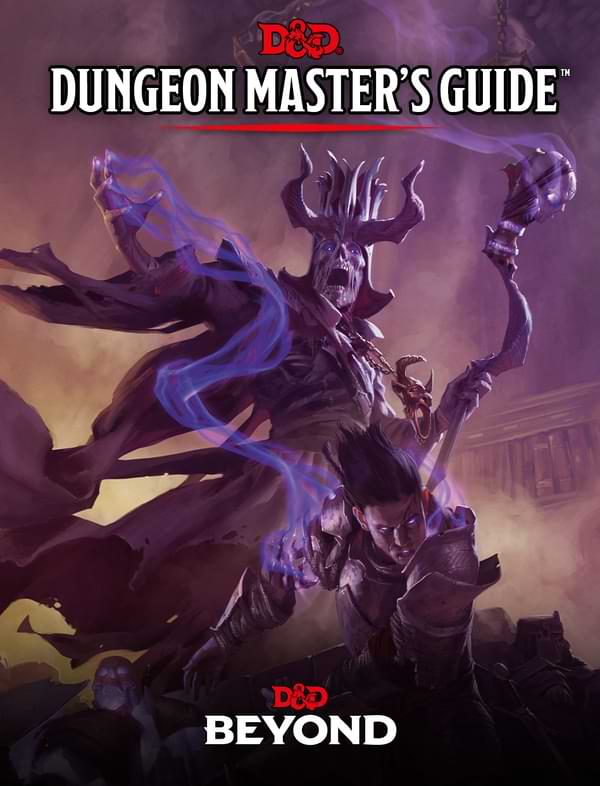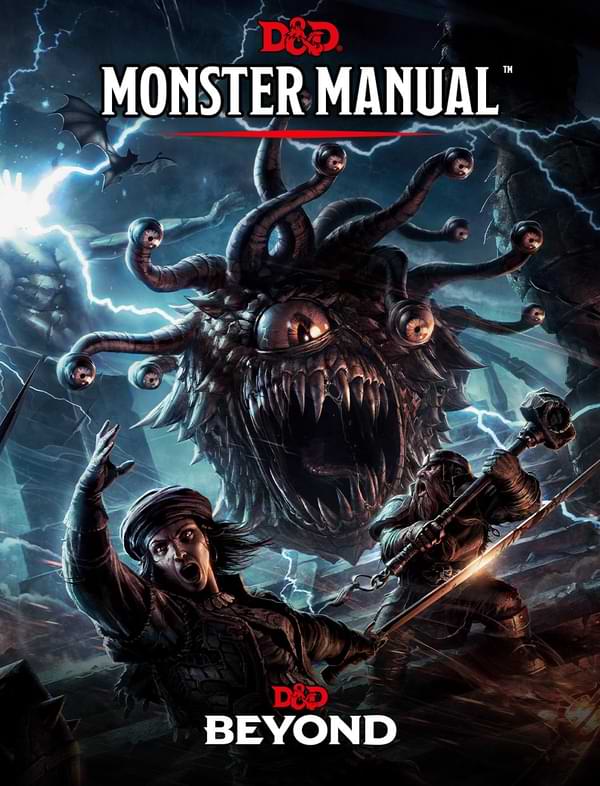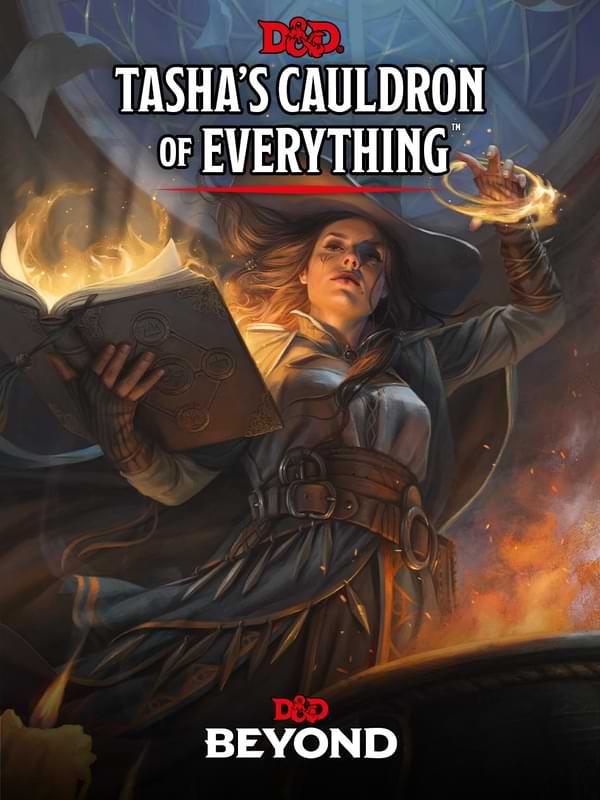D&D Beyond offers the Basic Rules of fifth-edition Dungeons & Dragons for free. These rules help you explore the game and get a feel for the different races, classes, and monsters without any investment.
But if you’re interested in seeing the breadth of character creation options available in the books — or you want to pick up tools to run your own game — we recommend the following D&D books for beginners:
Share your books with other players
D&D Beyond users with a Master-tier subscription can freely share books they’ve purchased with players in their campaigns.
To do so, create a campaign. Then, navigate to your campaign’s page and select “Enable Content Sharing.” Players who join your campaign will automatically have access to your purchased books on D&D Beyond. You can share content with up to 12 players in each of five campaigns.
Player’s Handbook
 The Player’s Handbook is the quintessential book for new players. It includes everything you need to create characters, including the core classes, races, backgrounds, and spells. You’ll also find the rules for multiclassing and feats, which are optional rules that can further customize your characters:
The Player’s Handbook is the quintessential book for new players. It includes everything you need to create characters, including the core classes, races, backgrounds, and spells. You’ll also find the rules for multiclassing and feats, which are optional rules that can further customize your characters:
- Multiclassing. You can gain levels in two or more classes, allowing you to mix their abilities. A lot of abilities are front loaded in classes and can result in powerful and flavorful combinations. A wizard who takes two levels in fighter can use the Action Surge feature to cast two spells in a turn, for example. But you might simply decide that your barbarian character has taken an interest in yodeling and should pick up a few levels of bard.
- Feats. Whenever a player character receives an Ability Score Improvement, they could pick up a feat to specialize in an area beyond what their class provides or to supplement their strengths. For example, a barbarian could choose Great Weapon Master to help deal damage instead of only acting as a shield; a wizard could choose Magic Initiate to gain two cantrips and a 1st-level spell.
The appendices of the Player’s Handbook expand on the lore behind D&D. You’ll find information on the gods, multiverse, and creatures you might encounter.
Dungeon Master's Guide
 A Dungeon Master runs more than a dungeon — they create and manage the whole world that the party interacts with. From voicing and puppeteering creatures to moaning like the wind, the Dungeon Master has a lot to do. The Dungeon Master’s Guide offers everything you need to run your own game.
A Dungeon Master runs more than a dungeon — they create and manage the whole world that the party interacts with. From voicing and puppeteering creatures to moaning like the wind, the Dungeon Master has a lot to do. The Dungeon Master’s Guide offers everything you need to run your own game.
You’ll learn about the different styles of play in D&D and how to create worlds. The book also contains magic items to shower on your player characters and all the nitty-gritty rules you need to run encounters, downtime activities, and make exploration exciting.
Here are more examples of what you’ll find in the book:
- Discover new settings: Want to take your player characters to the unpredictable Plane of Faerie? You’ll learn about fey crossings and the time-warping effects of the Feywild. Want to explore the Shadowfell, where undead creatures can hunt your player characters? You’ll find details in this book.
- Create villains: If you want to tell the story of a new crime boss who has overthrown The Xanathar Guild, the book has rollable tables to help you create a villain and determine their motivations.
- Designing adventures: Dreaming up a plot for a session or entire campaign can be challenging. This book offers guidance on structuring an adventure and has rollable tables for determining the quest the party receives, how you might introduce it, the climax of the adventure, and complications the party will encounter.
Looking for an adventure?
If you're a new Dungeon Master, learning the rules of the game on top of writing and running your own campaign can be a challenge. You might also find that building your own world is easier when you have published material to reference. If you're looking for recommendations on an adventure to run, check out our primer of the best adventures for new Dungeon Masters.
Monster Manual
 The Monster Manual provides the stat blocks on about 500 monsters drawn from mythologies across the world. If you want classical monsters like werewolves and vampires, you’ve got ‘em. If you want fantastical aberrations like floating eyeballs and space lizards, you’ve got ‘em. If you want elemental entities like sentient flames — that’s right, you’ve got ‘em.
The Monster Manual provides the stat blocks on about 500 monsters drawn from mythologies across the world. If you want classical monsters like werewolves and vampires, you’ve got ‘em. If you want fantastical aberrations like floating eyeballs and space lizards, you’ve got ‘em. If you want elemental entities like sentient flames — that’s right, you’ve got ‘em.
Dungeon Masters don’t have to use a monster as a great, big, physical adversary. Here are some other ways you might use the monsters found in the Monster Manual:
- An unexpected ally. Creatures could give advice or blessings. If the party is working to save a forest, a unicorn might appear to protect them from dangers. In dungeons, flumphs could foreshadow what’s ahead by changing colors to depict whether they’re amused, scared, or angry.
- To offer needed exposition. A guardian naga could be seeking to retrieve a magical relic that the party is after and offer a short history lesson on the item.
- Serve as an adventure hook. A sprite caught in a traveling circus might offer to draw a treasure map if you help them escape.
- Provide moral quandaries. Will player characters make a deal with a green hag for the greater good? Will they put innocents in danger to capture or kill a vile creature?
- Be the base for a homebrew creation. D&D Beyond lets you take a published creature and use it as a base for your homebrew creations.
Explore free creatures in the Basic Rules
The Basic Rules on D&D Beyond offer free creatures for you to use in your fifth-edition D&D game. Click here to begin browsing creatures. If you want to see creatures found only in the Basic Rules, select “Show Advanced Filters” and then fill in the “Sources” section with “Basic Rules.”
Tasha's Cauldron of Everything
 Tasha herself is a chaotic non-player character, and her book introduces a slew of new character options that will have players drooling. Tasha’s Cauldron of Everything includes new subclasses, spells, feats, and magic items, as well as the custom lineage option, which lets you customize your starting race or create a new one.
Tasha herself is a chaotic non-player character, and her book introduces a slew of new character options that will have players drooling. Tasha’s Cauldron of Everything includes new subclasses, spells, feats, and magic items, as well as the custom lineage option, which lets you customize your starting race or create a new one.
Every class receives at least one brand-new subclass in this book. These include the Armorer artificer, Way of the Astral Self monk, Rune Knight fighter, and Twilight Domain cleric. Subclasses that were previously printed across several different publications are reprinted here, as well.
Aside from new spells, you’ll also find that some existing spells have been added to new classes. A lot of the new feats in the book can also be taken by just about any character, expanding your ability to customize your character.
Dungeon Masters will enjoy the 47 new magic items presented in Tasha’s Cauldron of Everything. Magic tattoos, in particular, can be a fun addition to your campaign, while items like the bloodwell vial can help players get more mileage out of class abilities.
But some of the most important content for Dungeon Masters is found in the latter parts of the book. There, you’ll find the long-awaited session zero blueprint — the meeting that the Dungeon Master and players should have before the start of a campaign. It discusses how everyone at the table can communicate their wants and needs and create a safe and inviting space.
Which D&D books should you buy first?
If you’re a new player to Dungeons & Dragons, the Player’s Handbook is a great place to start. Once you’re familiar with the system — or if you’re just raring for more character creation options — Tasha’s Cauldron of Everything is a great purchase for your second book. In addition to new content, it consolidates character options found in other books like Eberron: Rising From the Last War, which first introduced the artificer class.
For Dungeon Masters, the Player’s Handbook and the Dungeon Master’s Guide are must-haves for understanding the rules of the game and running it. Although the Monster Manual is an important addition to your collection, if you need to hold off on the purchase, you could make do with the free creatures offered in the Basic Rules. When you’re ready to level up your and your player’s game experience, snag a copy of Tasha’s Cauldron of Everything.
Jenn Jones (@jennesai) is a writer, hiker, cosplayer, and avid consumer of board games. She lives in Charlotte with way too many paint supplies, never enough dice, and one cat.








-
View User Profile
-
Send Message
Posted Nov 20, 2021Pretty good choices for rulebooks!
Sounds like you intend to get into DMing. Unless you want to double dip, buying the rulebooks and adventures digitally instead is nice. With all the hyperlinks, I very much prefer to DM with a laptop instead of a pile of books. That's personal preference, though; think it over. (A shared physical Player's Handbook is nice for the table, though.)
The Tyranny of Dragons adventures are probably cheap because they were collected and revamped in a single book. You might want to consider getting that instead of the older editions.
As for the adventure collections: Tales From the Yawning Portal is going to give you some real classics, and the low-0level adventures of aged wonderfully. Ghosts of Saltmarsh, with a little reworking, has the best possibility to turn into a campaign; but it's also full of "watercooler" moments in some mid-level adventures that stand alone well. Candlekeep Adventures, because it has multiple authors, has the most variety and are the best as absolute one-shots instead of as a campaign. All my opinion, of course; there are more thorough reviews out there.
Have fun!
-
View User Profile
-
Send Message
Posted Nov 20, 2021Solid choice. PHB is kinda "must have" cause of the spells and most races; Xanathar has both a good measure of player material and some "missing chapters from the DMG" (better encounter planning, traps, etc).
Tasha's... a mixed bag. The subclasses are okay, but some of the additional rules are turning some of the basic D&D staples upside down, and some of the feats are turning the unique feature of some classes into a generic feat that anyone can learn. If you only need the sidekick generation rules, you might be better off grabbing the Essential Kit instead somewhere (I presume you have the other one), that would also give you a lot of useful extras for the table. (Note, buying Tasha's on DnD Beyond won't let you create sidekicks on DnD Beyond, at least not yet...) Also note, if you get the Essential Kit, there's a voucher in it that gives you 50% discount on the PHB on DnD Beyond.
One copy of the PHB is useful, although if you have a tablet at the table (heh), and you own it on dnd beyond, that can suffice too, as it also have a feature physical books unfortunately can't have: search. But if you get a good deal on the gift set, it can be useful to have them around indeed.
As for adventures, I would wait with that until you have your group. If you get the essential kit, there is an adventure in it that could help you get through the first good couple of sessions, but what you need to know is what your group prefers. For example if they prefer RP over combat and dungeon crawl, then the Witchlight would be a better choice than, for example, Dungeons of the Mad Mage; but if they mostly want to loot and pillage dungeons and not that much into social interactions, then the other way around is the better idea. If you'll be the DM, you can probably easily find reviews and descriptions of the adventures in different spoiler levels to help you decide, but it's always better to choose an adventure that fits the party than the other way around.
-
View User Profile
-
Send Message
Posted Nov 20, 2021Thanks for the reply, it's much appreciated.
I also plan to play duets with my wife, so I need/want to get into DMing for sure. I've actually ordered The Essential Kits as it can be nicely combined with the LMOP adventure from The Starter Set and it provide a code for 50% off from the PHB on Beyond + it unlocks supplementary content for the Dragon of Icespire Peak adventure (on Beyond). I love to have physical books and with adventure ones you can have notes and bookmarks as well.
I didn't know about Tyranny of Dragons being revamped, I'll check it out. Of course Amazon (DE) doesn't have it, neither do other on-line stores. I guess it was sold out.
Great presentation of the adventure books, thanks. I am glad my assumptions about them were correct :)
-
View User Profile
-
Send Message
Posted Nov 20, 2021@Edem
I've actually already ordered The Essential Kits as it can be nicely combined with the LMOP adventure from The Starter Set and, as you have also mentioned, it provide a code for 50% off from the PHB on Beyond + it unlocks supplementary content for the Dragon of Icespire Peak adventure on Beyond (not sure if it will unlock the entire Essential Kit bundle, I'll see next week) .
So I will have the PHB on Beyond next week and right now I'll could use my 20% welcome discount on Xanathar's + Tasha's (maybe, not sure yet). As far as I know on Cyber Monday there will be another sale (probably) so I still have some time to think about what other books might be worth buying, at this stage, here on Beyond.
-
View User Profile
-
Send Message
Posted Dec 9, 2021Returning player.
I am 54 and have not played since I was 12, when the original Deities and Demigods(With the Melnibone pantheon) was still published.
Can you point me to a place where I might learn what the abbreviations are? Obviously, PHB is "Player's Hand Book," but after that, I am lost.
Thank you.
-
View User Profile
-
Send Message
Posted Dec 9, 2021If in doubt, try looking at the "sources" list here in D&D Beyond, and you can often work out an abbreviation yourself.
The ones you'll see often are:
PHB = Player's Handbook
DMG = Dungeon Master's Guide
MM = Monster Manual
Those three are the original core rulebooks.
"Extended" core rulebooks, with optional material, that are frequently referenced (especially in this thread):
SCAG = Sword Coast Adventurer's Guide - one of the first "extended" core books released, meant mostly as a lorebook for the Forgotten Realms, much of its "crunch" has been repeated in other books.
VGtM or Volo's = Volo's Guide To Monsters - provides deeper lore on several common monsters and adds new monsters, also gives rules for "monstrous" races.
XGtE or Xanathar's = Xanathar's Guide to Everything - introduced a lot of popular subclasses and new spells for players; also some rules and suggestions for DM's
TCoE or Tasha's = most recent extended rulebook, introduces some new (sub)classes and spells, collecting some from other places; some DM ideas and mechanics, new magic items; introduces customizing your background (i.e. changing racial ability score increases), which some people quite dislike, but which is definitely the way of the future for D&D (all races introduced in campaign books had unearthed arcana since Tasha's have specified that you should choose whatever skill increases you want)
In reference to rules, you might also see:
SAG = Sage Advice Compendium - Rules clarifications on commonly asked questions. Not an official release. You can get it in PDF from the WotC (https://dnd.wizards.com/articles/sage-advice) or here on D&D Beyond.
UA = Unearthed Arcana - Playtest material, usually player options, often soon to be released in an official manner. You can get it from the WotC website (https://dnd.wizards.com/articles/unearthed-arcana) but I'd ignore it if you're just getting back into the hobby.
Of course just about anything else can be abbreviated, unless it's something really common (AC is still Armor Class!) you can probably figure out from context!
Welcome back, have fun!
-
View User Profile
-
Send Message
Posted Jun 7, 2022I purchased the physical books before coming to this website. Do I need to purchase the books all over again on the website in order to use the features only available when you buy the books for the website? Or is there a way I can register my books so I can use the features?
-
View User Profile
-
Send Message
Posted Jun 7, 2022That's a recurring question. You have bought the print edition of the rules (90% of what you paid was in order to have a physical item in your hand). In order to be able to use the digital version of the rules, you have to buy the digital edition on the website, but you have options:
- if you just want ro be able to read the things digitally on the website, you only need to buy the Compendium part of the books
- if you want to use a certain (sub)race, (sub)class, spell or item in the charaterbuilder that is not part of the free rules, you can buy just that one thing; or just certain aspects (i.e. all spells or all races) from a specific book, and you can mix&match
- also any partial purchase you make from a certain book contributes to the total price, and gives you a rolling discount if you want to buy that book - for example, if a book costs $40, the races togehter in that book cost $10 and a single race cost $3, buying one race means you can later buy the rest of the book for $37 or the rest of the races for $7; should you decide to buy another race later for another $3, these are further reduced to $34/$4; and if you buy out the rest of the races, then the book will be reduced to $30 for you.
- note that the monthly subscription does not unlock paid content; it "only" covers access to unlimited character slots, beta/alpha tools, and in case of a master subscription, content sharing in 5 separate campaigns.
Note, there is an exception for the Essential Kit, which contains a code to unlock its digital counterpart for free, and a 50% discount coupon for the PHB. And now that Wizards have recently acquired DDB, there might be other discounts, but the bottom line is, the actual content is only a small portion of the price, the majority is the production, whether it is painted on dead trees by a machine, or converted into electric ones and zeroes by a team of developers (and some machines).
-
View User Profile
-
Send Message
Posted Aug 15, 2022Players handbook is incredibly useful. Has absolutely everything you need for a campaign. 5 stars
-
View User Profile
-
Send Message
Posted Dec 16, 2022Hi this is so useful
-
View User Profile
-
Send Message
Posted Jan 9, 2023I just wish I could just add the hard cover books I have into Beyond. Too bad there isn't a way to do that.
-
View User Profile
-
Send Message
Posted Jan 22, 2023What do you say for descriptions
-
View User Profile
-
Send Message
Posted Dec 8, 2023two of these books are free
-
View User Profile
-
Send Message
Posted Dec 8, 2023Not sure what makes you say that as none of them are free - the free SRD (also known as Basic Rules) only partially covers the PHB (for example, each class has only one subclass, and races with subraces only have one subrace each).